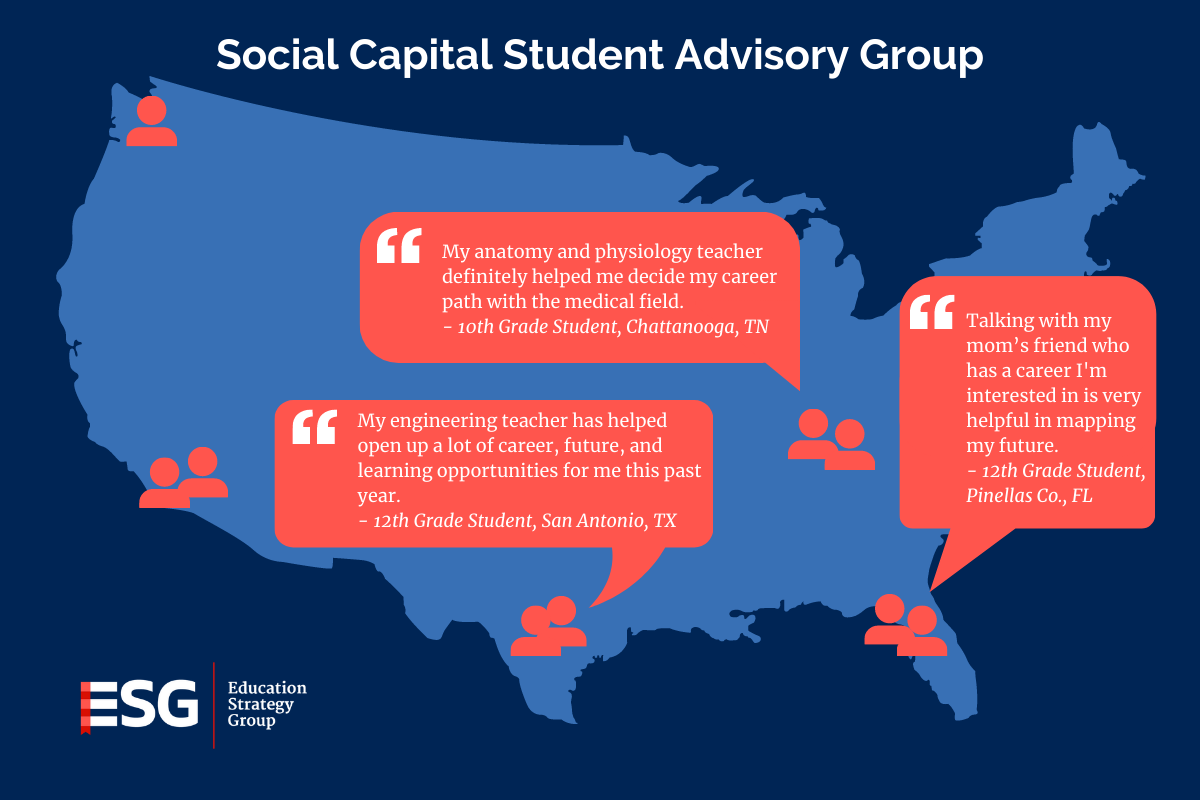Integrating Student Voice in Social Capital Development

At ESG, we understand and value that education efforts to better support students on their path to prosperous futures should consider thoughts and suggestions from students themselves on the ways they can best be served. That’s why we strive to ensure that learner perspective is represented across our various projects, whether via empathy interviews conducted by the communities we are working with or direct engagement with students when possible. Integrating student voice ensures we hear directly from the intended beneficiaries of our work and that the strategies, tools, and resources we utilize are the ones that can be most impactful.
Last year, ESG kicked off new work funded by the Siemens Foundation to build social capital development equitably into career pathways and related programs in five school districts across the country. Social capital refers to the personal and professional connections and networks that help open doors to new opportunities—or, quite simply, who you know. Through this project, we have worked to intentionally include student voice at various steps along the way.
Student Surveys
The sites involved in this initiative have spent nearly a year designing pilots to test social capital strategies with the goal of helping build students’ professional networks, particularly for those who are underrepresented in STEM fields. Sites began their work by administering a modified version of the Social Capital Assessment + Learning for Equity (SCALE) survey, designed by the Search Institute, to students.The survey is designed to help leaders and practitioners capture data on how their organizations are helping young people develop and strengthen social capital. The results from the survey were used to inform the development of a pilot; in particular, they helped sites identify the strategies that would most directly address the areas where students felt they had less opportunity to develop and mobilize their networks. A second wave of the survey will be administered at the end of the school year to assess how student perceptions on their social capital and networks have changed as a result of the pilot.
Relationship Mapping
Each of our communities has also helped students map their current relationships (an asset-based approach recommended by the Clayton Christensen Institute) to better understand who the people are in their lives—from those with whom they have close relationships to those who are primarily acquaintances—who can be part of their community of care; and develop goals around how they would like to further build and diversify their relationships. This strategy signals to students (and the adults guiding them through the exercise) that they come into this social capital conversation with existing resources and supports through their various communities that can help them reach their postsecondary and career aspirations. These maps have also informed who the sites have invited to engage with students, for example, as classroom or panel speakers.
The Student Advisory Group
To gain a project-level student perspective on our social capital efforts, we have pulled together a Student Advisory Group to give students from across the communities participating in this work a seat at the table. The group will be convened several times over the course of the project for three core functions: (1) to advise on ways in which we can continuously improve the site-based pilots; (2) to provide voice and a grounding by which site teams will better understand what students already know about social capital and what they want to know; and (3) to reflect on their experiences as participants in the pilot to inform plans for sustainability and replication. At each meeting, we also facilitate further social capital building using the tools and resources we have shared with site teams. Students are compensated for their time and expertise.

As we continue to learn alongside our sites about the challenges, opportunities, and successes in helping students build their professional networks, student engagement will play a critical role in ensuring that we are placing them at the center of what gets tested, built, and scaled moving forward.



